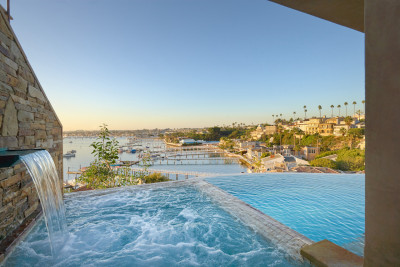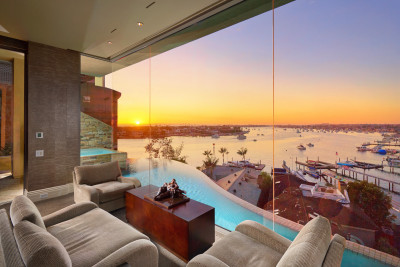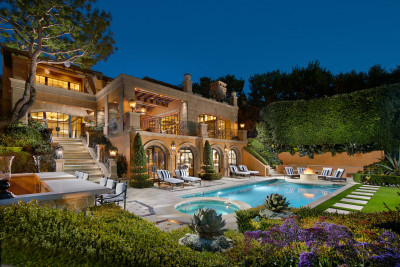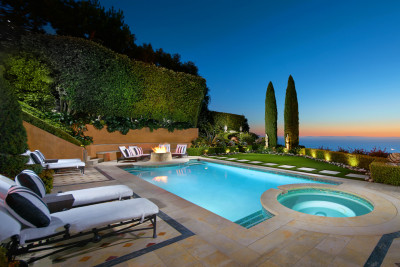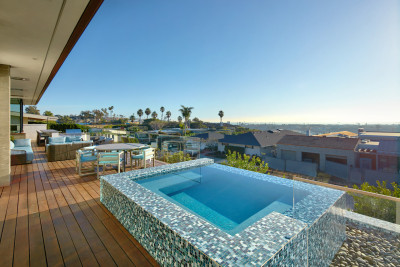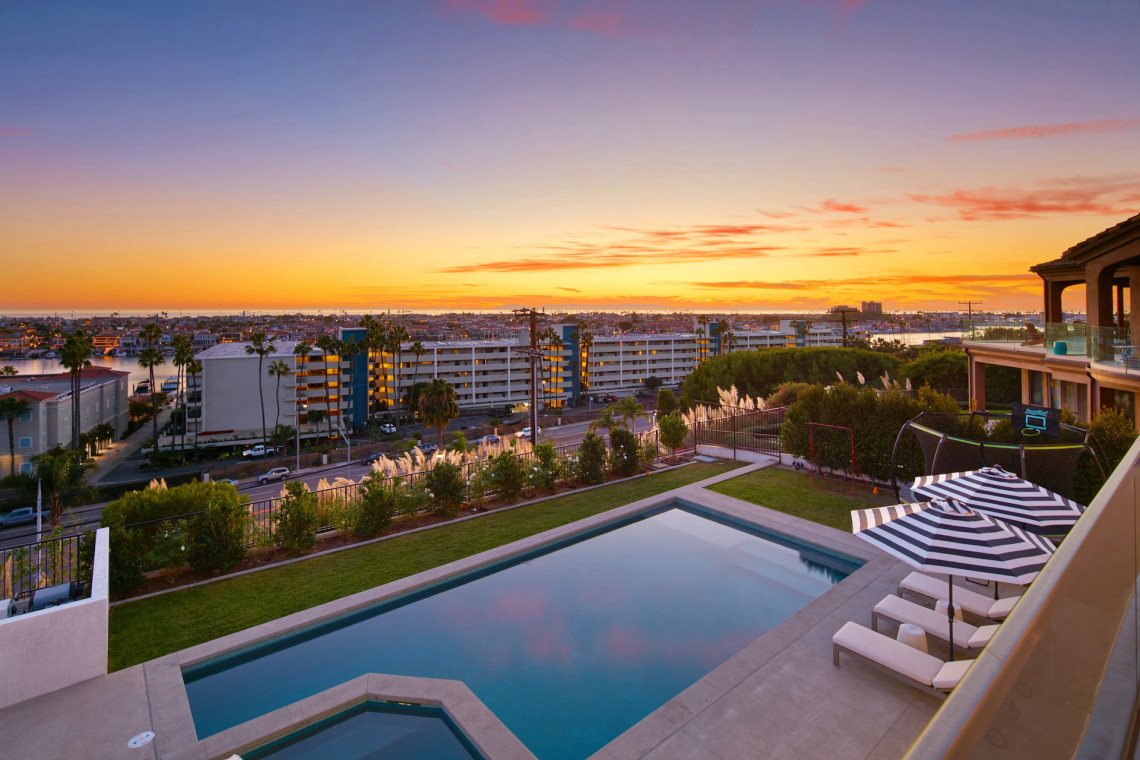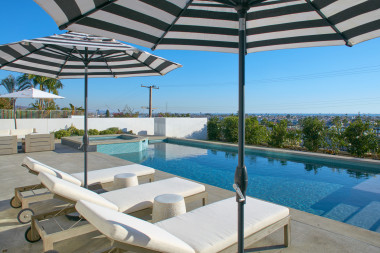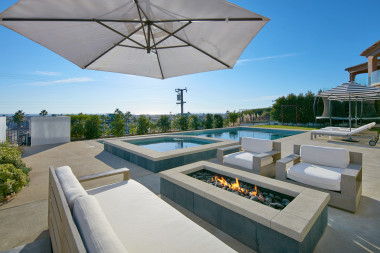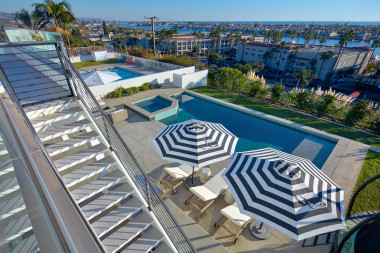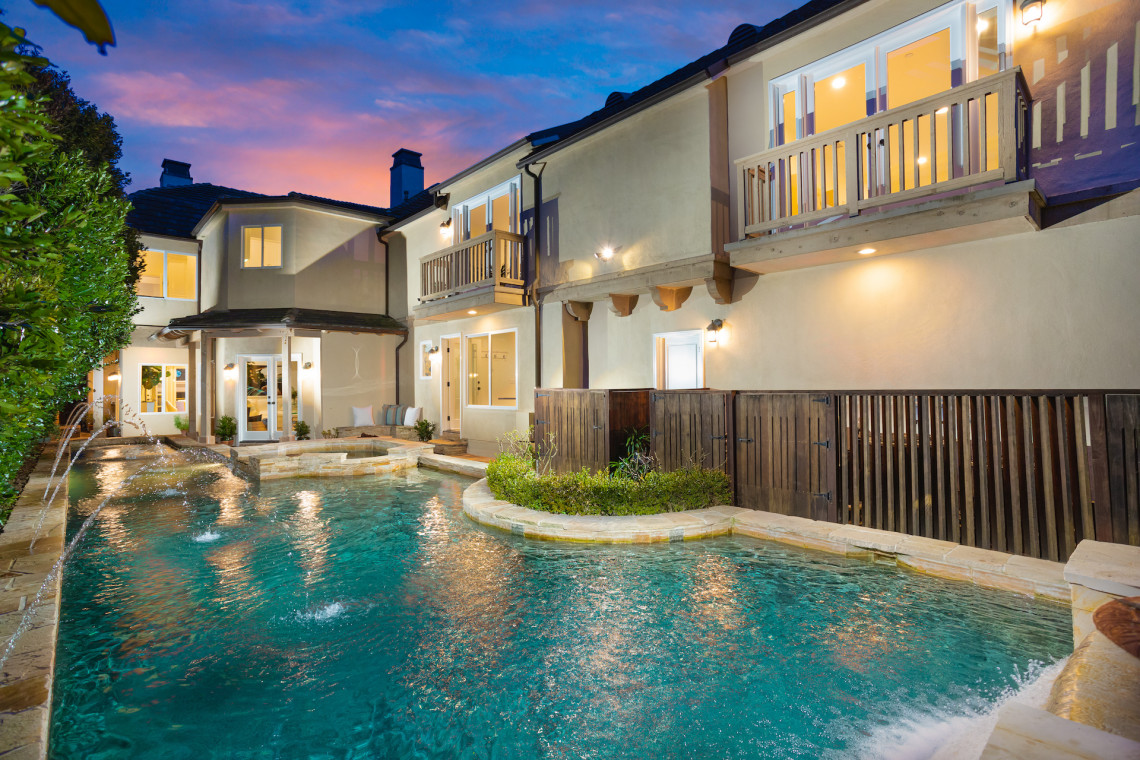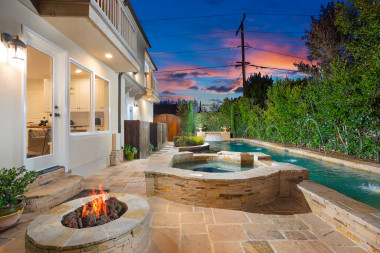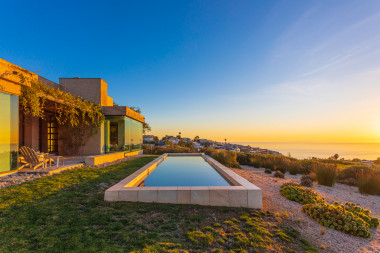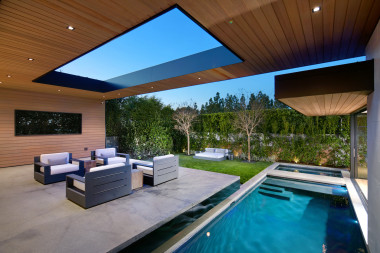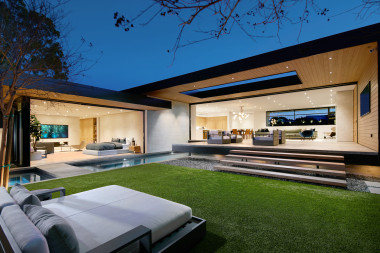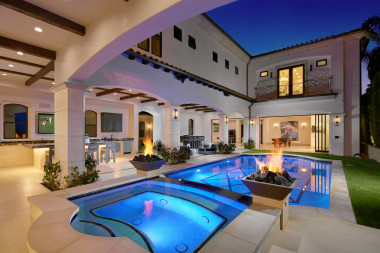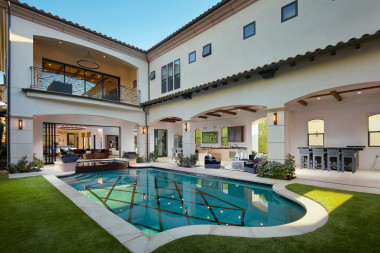The Art of Designing A Family Pool
Designing a backyard pool is an intimidating project. Safety is, of course, first and foremost. However, we all desire a pool oasis that is serene and beautiful. Creating a family pool that is both safe and aesthetically pleasing may seem impossible, but it is actually very possible with the right guidance.
Designing a family pool has very different considerations than designing a pool that’s a visual showpiece to be used occasionally by adults. When constructing a pool for the entire family, be sure to focus on both the safety and functionality during the design process. The good news is you can create a stunning pool, illuminated waterfalls, and a quiet spa all with strict safety measures in place.
To find out how, I spoke to our luxury partner LC Pool Design + Consultation Founder Lisa Cook for her design advice on how to create the family pool of your dreams. “From the materials that are the most durable and slip-resistant, to safety enclosures and step arrangements, they can still be gorgeous,” Lisa says. “It is important to dive into the details throughout the entire process. If one aspect is overlooked, it can be the difference between a pool you love, and a pool that frustrates you.”
Here are Lisa’s top considerations to design a pool environment that is both sophisticated and safe:
Proper Pool Deck: Take care when choosing the material that surrounds the pool. Certain types of stone, concrete, marble and tiles can absorb the heat to the point that children and pets can suffer from burns on their feet. Tiles can also be very slick when wet. Test out the materials and ask questions about their slip resistance and heat absorption.
Gates & Fencing: It is absolutely critical to select and examine safety gates, fencing and pool covers when constructing a family pool. They provide a vital protective layer, keeping little feet from entering the pool area when not monitored. In the early design phase examine the three types: Retractable Covers, Mesh Fencing and Glass Gates. Whichever safety gate and fencing you choose, you do need AT LEAST ONE and it’s best to pair it with a pool cover.
Pool Placement: Ideally there should be distance between the home’s backdoor and the pool, to install safety measures. For instance, a popular layout is to have the indoor living room doors lead directly into the outdoor living room space, and then the pool is right next to the outdoor seating. For family style pools, this intimate layout is not ideal as it is more difficult to include a mesh fence or other safety gates around the pool.
Pool Shape: If outdoor space is limited for fencing, the best pool shape is a rectangle pool as it can be covered with an automatic cover. Rectangle pools are attractive, easy to fit within the space allowed, and very easy to cover. Kidney, lagoon or other oddly shaped pools usually require a mesh or glass fence. Automatic covers only work with standard rectangles.
Depth: If you’re going to commit to a deep end make sure it’s the proper depth. A deep end must be six feet legally for diving, it is also safer all the way around for jumping especially when children are over the age of 8. As long as 1/3 of your pool length is deep, that’s plenty. And, do not put your deep end in the middle. Some pool contractors suggest this as a way to get more shallow space, but it is a drowning hazard! It’s too confusing and dangerous for children.
Depth: If you’re going to commit to a deep end make sure it’s the proper depth. A deep end must be six feet legally for diving, it is also safer all the way around for jumping especially when children are over the age of 8. As long as 1/3 of your pool length is deep, that’s plenty. And, do not put your deep end in the middle. Some pool contractors suggest this as a way to get more shallow space, but it is a drowning hazard! It’s too confusing and dangerous for children.
Trends: Don’t succumb to the trends. For example, a Baja step or shelf, a ledge that can be built along the inside of your pool, is trendy. Unfortunately, they never really get as much use as you think and they take up a fair amount of pool real estate. Unless your pool is quite large, don’t give up too much space just for a large step. You’re better off having a bench that runs along one side of the length, at least halfway. Rather than being trendy, it’s always important to ask yourself, is it functional and will it fit well with our design?
Jacuzzi Placement: This can be a tricky one. For a family pool I recommend placing a jacuzzi at the shallow end of the pool versus the deep end. Once children are old enough to start utilizing the deep end they will gravitate to it like bees to honey. There will be endless jumps and dives and playing on large rafts in the deep end. You don’t want the jutting sharp corner of a jacuzzi anywhere near children during these activities. If possible, you’re better off having the jacuzzi be entirely off to the side or at least situated at the shallow end.
Chemical Considerations: No matter what type of chemical concentration you choose, you will still need chlorine. Even salt water pools need chlorine. Don’t be afraid of it. It is the most stable, reliable cleaning solution for pools. Chlorine is the only substance that effectively kills algae and bacteria and it kills COVID-19 when maintained at a proper level. It is also the easiest to maintain, the most cost effective and has the highest success rate for chemical stability. Additionally, it won’t discolor your pool surface the way that saltwater will and it won’t erode your plumbing. If you have a concrete pool surface, definitely think twice before using saline. Saline pools are less stable and algae buildup is common which means you’d still need to ‘shock’ the pool from time to time with a combination of acid and chlorine.
Whether you are constructing a new pool or renovating an existing pool, take the time to plan a pool that is right for your family now and for your family as it grows. Define your wish list, budget, timeline and consider the needs of your children at various ages. Be sure to ask yourself: How long do you plan to live in this home? Will the pool still be the perfect design when the little ones are water safe teens? Then work with the experts to sketch out the ideal family pool that is both safe, stylish and will grow with your family. Soon you will be enjoying games of Marco Polo, enjoying the surrounding beauty, and have peace of mind knowing it is a safe environment for your whole family!
*Article posted with permission from Coldwell Banker Global Luxury
The above is a guest post by Chief of Organized Living & NorthStar Moving Company Co-Founder Laura McHolm.
.png)




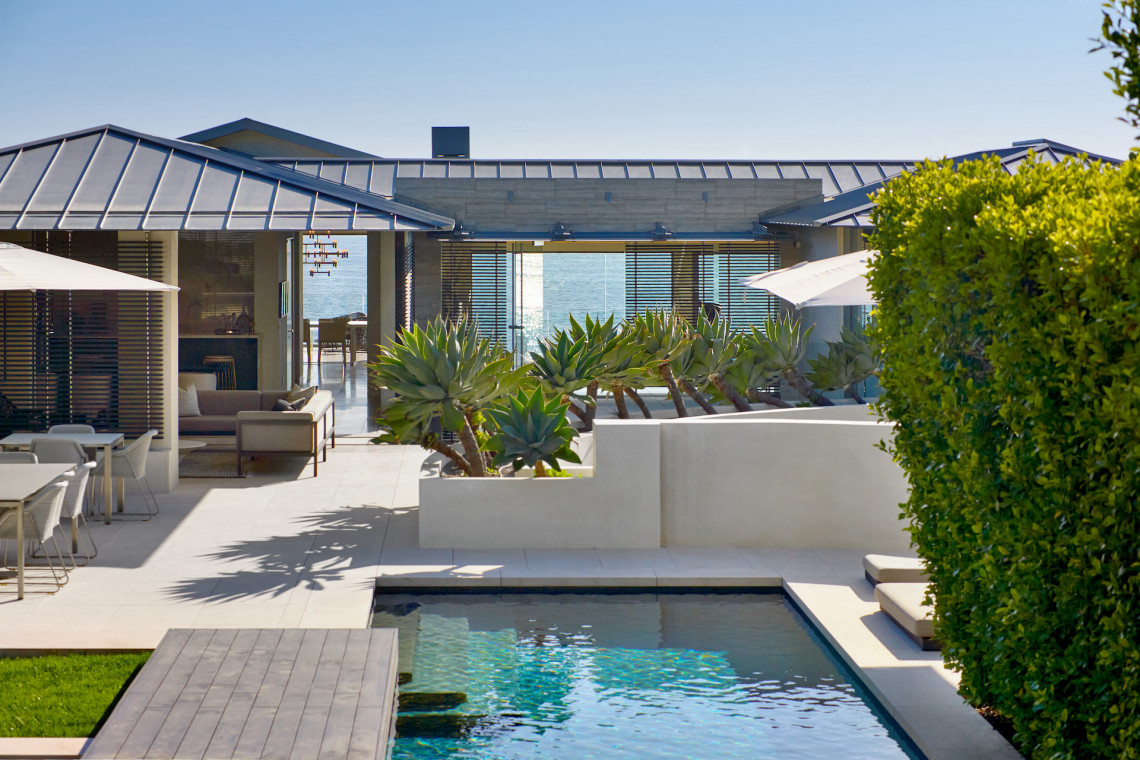
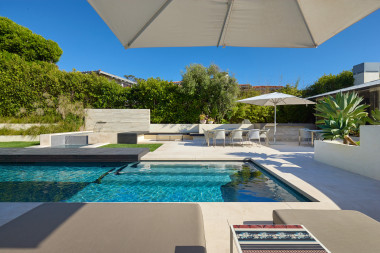
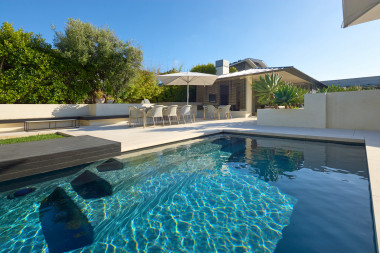
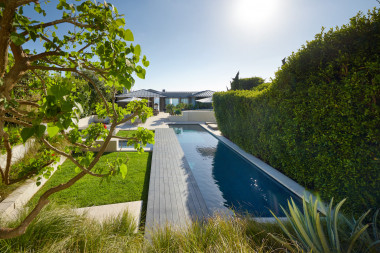
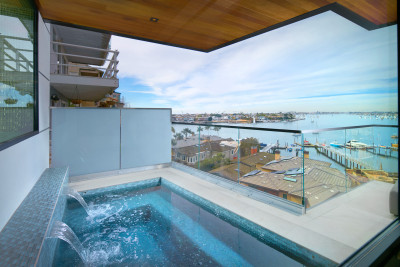
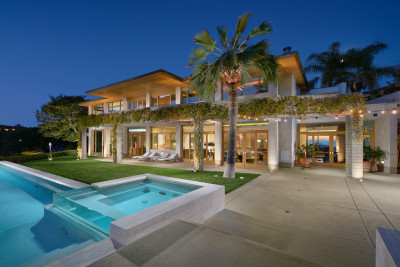
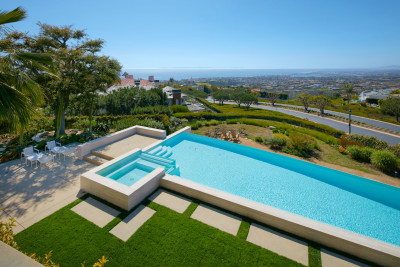
.jpg?w=400)
